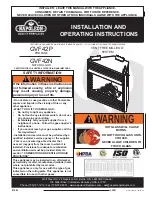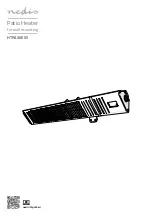
1.
Do not attempt to install, repair, or service this heater
or the gas supply line unless you have continuing
expert training and knowledge of gas heaters.
Qualifications for service and installation of this
equipment are as follows:
a. To be a qualified gas heater service person, you
must have sufficient training and experience to
handle all aspects of gas-fired heater installation,
service and repair. This includes the task of
installation, troubleshooting, replacement of
defective parts and testing of the heater. You
must be able to place the heater into a continuing
safe and normal operating condition. You must
completely familiarize yourself with each model
heater by reading and complying with the safety
instructions, labels, Owner’s Manual, etc., that is
provided with each heater.
b. To be a qualified gas installation person, you must
have sufficient training and experience to handle
all aspects of installing, repairing and altering gas
lines, including selecting and installing the proper
equipment, and selecting proper pipe and tank
size to be used. This must be done in accordance
with all local, state and national codes as well as
the manufacturer’s requirements.
2.
All installations and applications of L.B. White heaters
must meet all relevant local, state and national
codes. Included are L.P. gas, electrical, and safety
codes. Your local fuel gas supplier, a local licensed
electrician, the local fire depar tment or similar
government agencies, or your insurance agent can
help you determine code requirements.
-- ANSI/NFPA 58, latest edition, Standard for
Storage and Handling of Liquefied Petroleum
Gas and/or
-- ANSI Z223.1/NFPA 54, National Fuel Gas
Code
-- ANSI/NFPA 70, National Electrical Code.
3.
Do not move, handle, or service heater while in
operation or connected to a power or fuel supply.
4.
This heater may be installed in areas subject to
washdown. This heater may only be washed on the
external components. See Cleaning Instructions. Do
not wash the interior of the burner box or the tubes.
Use only compressed air, soft brush or dry cloth to
clean the interior of the heater and it’s components.
After external washdown, do not operate this heater
until it is completely dry. In any event, do not operate
the heater for at least one hour af ter external
washdown.
5.
For safety, this heater is equipped with an differential
air pressure switch. Never operate this heater if this
safety device has been bypassed. Do not operate this
heater unless this feature is fully functioning.
6.
The heater is designed to operate only with its access
door closed and latched. Do not operate the heater
with its burner box access door open.
7.
Do not block air intakes or discharge outlets of the
heater. Doing so may cause improper combustion or
damage to heater components leading to property
damage or animal loss.
8.
The hose assembly shall be visually inspected on an
annual basis. If it is evident there is excessive
abrasion or wear, or if the hose is cut, it must be
replaced prior to the heater being put into operation.
The hose assembly shall be protected from animals,
and contact with hot surfaces during use. The hose
assembly shall be that specified by the manufacturer.
See parts list.
9.
Check for gas leaks and proper function upon heater
installation and before building repopulation.
10.
This heater should be inspected for proper operation
by a qualified service person at least annually.
11.
Always turn off the gas supply to the heater when not
in use.
12.
T h i s h e a te r i s e qu i p p e d w i t h a t h r e e - p ro n g
(grounding) plug for your protection against shock
hazard and must be plugged directly into a properly
grounded three-prong receptacle. Failure to use a
properly grounded receptacle can result in electrical
shock, personal injury, or death.
13.
Direct ignition heaters will make up to three trials for
ignition. If ignition is not achieved, the control system
will lock out the gas control valve. If gas is smelled
after system lock out has occurred, immediately close
all fuel supply valves. Do not relight until you are sure
that all gas that may have accumulated has cleared
away. In any event, do not relight for at least 5
minutes.
14.
Use only approved gas hose or approved flexible
connectors which are rated for use with propane or
natural gas.
7








































